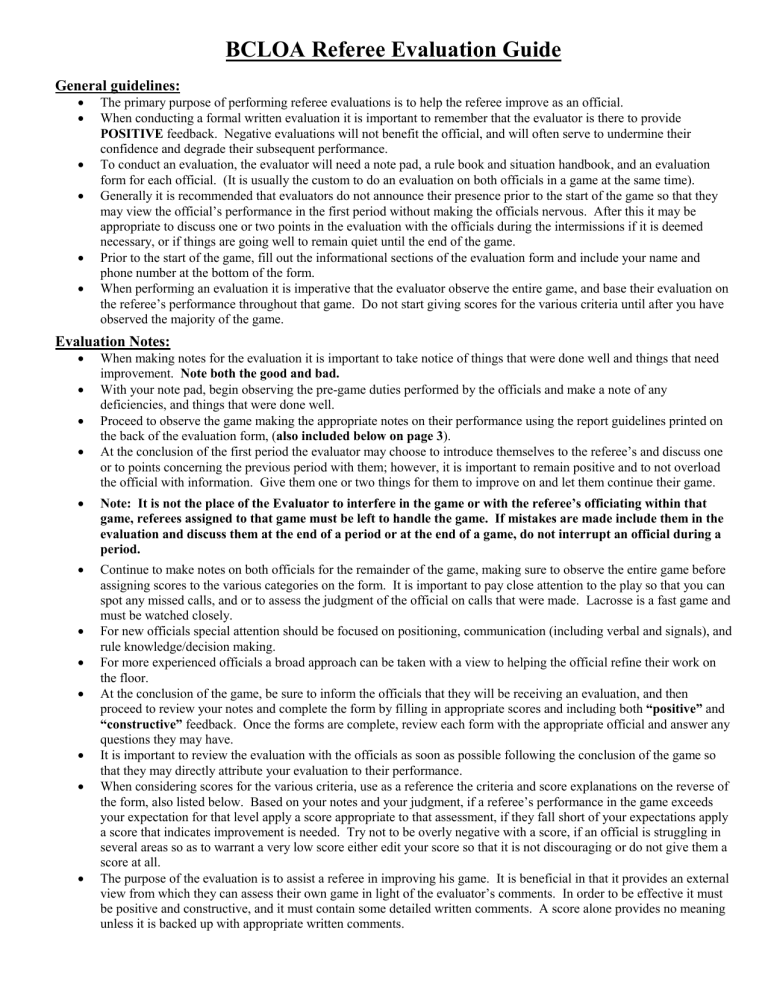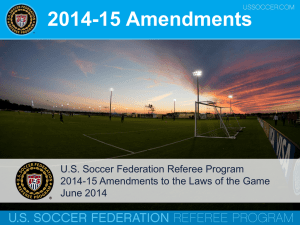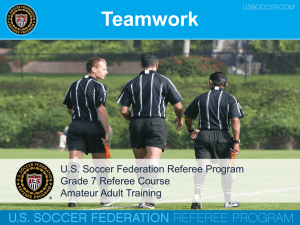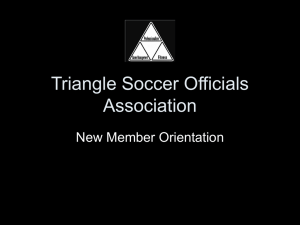Referee Evaluation Guide

BCLOA Referee Evaluation Guide
General guidelines:
The primary purpose of performing referee evaluations is to help the referee improve as an official.
When conducting a formal written evaluation it is important to remember that the evaluator is there to provide
POSITIVE feedback. Negative evaluations will not benefit the official, and will often serve to undermine their confidence and degrade their subsequent performance.
To conduct an evaluation, the evaluator will need a note pad, a rule book and situation handbook, and an evaluation form for each official. (It is usually the custom to do an evaluation on both officials in a game at the same time).
Generally it is recommended that evaluators do not announce their presence prior to the start of the game so that they may view the official’s performance in the first period without making the officials nervous. After this it may be appropriate to discuss one or two points in the evaluation with the officials during the intermissions if it is deemed necessary, or if things are going well to remain quiet until the end of the game.
Prior to the start of the game, fill out the informational sections of the evaluation form and include your name and phone number at the bottom of the form.
When performing an evaluation it is imperative that the evaluator observe the entire game, and base their evaluation on the referee’s performance throughout that game. Do not start giving scores for the various criteria until after you have observed the majority of the game.
Evaluation Notes:
When making notes for the evaluation it is important to take notice of things that were done well and things that need improvement. Note both the good and bad.
With your note pad, begin observing the pre-game duties performed by the officials and make a note of any deficiencies, and things that were done well.
Proceed to observe the game making the appropriate notes on their performance using the report guidelines printed on the back of the evaluation form, ( also included below on page 3 ).
At the conclusion of the first period the evaluator may choose to introduce themselves to the referee’s and discuss one or to points concerning the previous period with them; however, it is important to remain positive and to not overload the official with information. Give them one or two things for them to improve on and let them continue their game.
Note: It is not the place of the Evaluator to interfere in the game or with the referee’s officiating within that game, referees assigned to that game must be left to handle the game. If mistakes are made include them in the evaluation and discuss them at the end of a period or at the end of a game, do not interrupt an official during a period.
Continue to make notes on both officials for the remainder of the game, making sure to observe the entire game before assigning scores to the various categories on the form. It is important to pay close attention to the play so that you can spot any missed calls, and or to assess the judgment of the official on calls that were made. Lacrosse is a fast game and must be watched closely.
For new officials special attention should be focused on positioning, communication (including verbal and signals), and rule knowledge/decision making.
For more experienced officials a broad approach can be taken with a view to helping the official refine their work on the floor.
At the conclusion of the game, be sure to inform the officials that they will be receiving an evaluation, and then proceed to review your notes and complete the form by filling in appropriate scores and including both “positive” and
“constructive” feedback. Once the forms are complete, review each form with the appropriate official and answer any questions they may have.
It is important to review the evaluation with the officials as soon as possible following the conclusion of the game so that they may directly attribute your evaluation to their performance.
When considering scores for the various criteria, use as a reference the criteria and score explanations on the reverse of the form, also listed below. Based on your notes and your judgment, if a referee’s performance in the game exceeds your expectation for that level apply a score appropriate to that assessment, if they fall short of your expectations apply a score that indicates improvement is needed. Try not to be overly negative with a score, if an official is struggling in several areas so as to warrant a very low score either edit your score so that it is not discouraging or do not give them a score at all.
The purpose of the evaluation is to assist a referee in improving his game. It is beneficial in that it provides an external view from which they can assess their own game in light of the evaluator’s comments. In order to be effective it must be positive and constructive, and it must contain some detailed written comments. A score alone provides no meaning unless it is backed up with appropriate written comments.
Game
Score:
%
Official's Name:
Division/League:
Home Team:
Date:
BCLOA Referee Evaluation Form
Partner's Name:
Location(Arena):
Visiting Team:
Start Time of Game:
Scoring:
Personal Characteristics:
1.
Appearance, Presence and Attitude
2.
Reaction to Pressure
Technical Characteristics:
3.
Pre-Game/Post Game
(Scored Separately)
4.
Face-Offs
5.
Positioning
6.
Procedures
7.
Rule Knowledge
8.
Signals
1st
Pre
Remarks:(see below)
(Per Period)
1st 2nd 3rd
2nd
Post
3rd
Game Management:
9.
Rapport and
Communication
10.
Keeping up with play
11.
Feel for the Game and
Game Management
Overall Scores:
1st
/50
2nd
/50
3rd
/50
Remarks: 1=Needs Improvement – 2=Satisfactory – 3=Good – 4=Very Good – 5=Excellent
Additional Comments:
Comments:
Evaluator’s Name:
Evaluator’s Signature:
Contact Number:
Official’s Signature:
Copies to: 1) Evaluator 2) Game Official This document is the property of the BCLOA and shall be submitted to the Chair of the BCLOA upon request.
BCLOA Evaluation Form Evaluation Criteria
Scores:
Scores are marked on a scale, 1 through 5; these score translate into the following rankings: Needs improvement, Satisfactory, Good,
Very Good and Excellent. These scores are applied based on the level of proficiency expected for the caliber of play being observed. A score of 3 indicates that performance is up to the expected level for the caliber of play, 4 is given where a referee fully meets expectations. If they encountered a challenge and responded well, and or have otherwise exceeded expectations a score of 5 is given. Scores of 1 or 2 means that deficiencies were observed in the referee’s performance and there is room for improvement.
Personal Characteristics:
1.
Appearance, Presence and Attitude:
This score reflects the dress and demeanor of the official. Does this official look the part and carry his or her self in a respectful and professional manner?
Attitude: Does the referee conduct his or herself professionally? Are they courteous and polite with the game’s participants and their partner? Are they open to polite communication? Do they work well with their partner? Do the referees work together as a team?
2.
Reaction to Pressure:
Rate the official a 3 if there has been no pressure at all. If an official has taken an easy game and made it difficult, then you mark down accordingly.
A 2 indicates the official had a tough game. 1 would indicate that the official is above their head at this level. An 4 or 5 indicates that there was pressure and that the official responded well. This characteristic is a good measure of an official’s overall confidence in his or her abilities.
Technical Characteristics:
3.
Pre-Game/Post-Game:
Pre-Game:
Did the official arrive on time? Did they have a pre-game discussion with their partner? Was the floor inspected, nets, doors and boards? Was the score sheet inspected? Did the referees introduce themselves to the teams and conduct an equipment inspection?
Post Game:
Do the officials watch the teams during their hand shake? Is the game sheet handled correctly and marked with the correct notations? Are reports written when necessary and if so are they completed correctly?
4.
Face-offs:
The scoring for face-offs includes quickness and asks the following questions: Does the official show courage, offer consistent support for their partner, and does the official demonstrate a strong consistent standard regarding a legal vs. illegal draw as set out by the CLA guidelines? Are the officials lining up correctly? A score of 3 is satisfactory, 1 or 2 indicate Improvement is needed, a 4 or 5 indicate smooth, fair and consistent face offs, with good communication with their partner and coverage of the floor.
5.
Positioning:
A mark of 3 indicates that the official has a good grasp of the positioning guidelines. A 4 shows that the official is consistently in good position and uses positioning to his advantage. A 5 shows the official is flexible in their use of position and has a good sense of where he needs to be on the floor.
A mark of 3 indicates the official meets minimum standards but has room for improvement. A mark of 2 or lower is cause for concern, and indicates the official is out of place at this level of lacrosse and needs further instruction and coaching. Things to watch for include lead official positioning, movement with the play up the floor, and position as trail official.
6.
Procedures:
This score reflects the official’s proficiency in several areas including: Breaking up fights, multiple penalty application, set up after penalties and goals. Are the clocks handled properly? Does the referee apply rule 60(b) “Leaving the Player’s/Penalty bench.”
7.
Rule Knowledge:
Based on use and knowledge of rules, score is adjusted to reflect whether or not there were errors in rule interpretation.
8.
Signals:
Signals should be clear and crisp. Referees are required to signal penalties twice, once when calling the penalty and a second time when reporting it.
Remember that signals communicate the referee’s actions to all participants in the arena, not just the score keepers.
Game Management:
9.
Rapport and Communication:
In this area we are rating interaction with coaches, players, and within the officiating crew. Is there too much or not enough conversation? Does the official try to officiate by just talking? Do the coaches display respect for the officials? Are the official’s actions clearly understood? Does the referee talk to the players, or is he or she quiet on the floor.
10.
Keeping up with play:
Officials must demonstrate an ability to keep up with the play and maintain proper positioning by not being caught up in the play or lagging too far behind the play. This score reflects the frequency and degree to which this happens.
11.
Feel for the Game and Game Management:
Questions addressed by this score include:
Does the official read and react to the many factors in and around the game? If it appears that the official’s strategy is to “call every penalty”, or at the end of the scale to, “let the boys play.” A mark of
4 or 5 indicates a very strong effective and consistent penalty standard and selection. An important issue here is: Does the official stay focused and concentrate for the entire game? Were there apparent mental lapses that affected the game? A mark of 2 or 1 would alert us that the individual is not accepting or does not understand the responsibilities of an official. A score of 3 means the official has met a minimum standard but could improve. Consistency is also a factor under this category: Does the official apply the rules consistently throughout the game? Are penalties applied evenly to both teams?
12.
Overall Game Score:
An overall score is provided that is a subjective grading that takes into account the referee’s overall performance in the game as a whole. This score is graded on a scale of 1 – 100 , and takes into account the numeric score given, out of 150, and converts this number into a percentage , which is then balanced against the evaluator’s overall assessment of the referee’s performance. The final mark is a score that reflects the evaluator’s assessment of the referee’s overall performance. A score of
75+ represents a minimum level of expected performance for the given level observed in the evaluation, 69 or below , indicates that the referee has struggled in this game or at this level and will need to be reevaluated, 80 and above indicates the referee had a strong performance and may be considered for a higher caliber of game.





